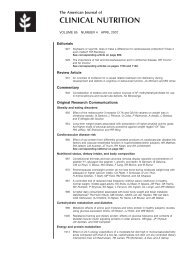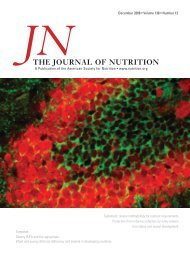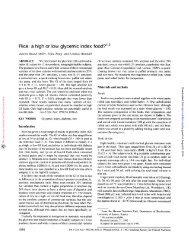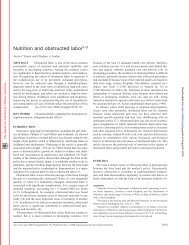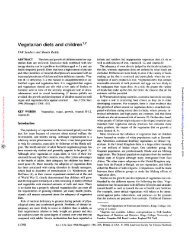Influence of Plane of Nutrition on Body Composition, Organ Size and ...
Influence of Plane of Nutrition on Body Composition, Organ Size and ...
Influence of Plane of Nutrition on Body Composition, Organ Size and ...
Create successful ePaper yourself
Turn your PDF publications into a flip-book with our unique Google optimized e-Paper software.
ENERGY UTILIZATION DURING REALIMENTATION 25271800 h. <strong>Body</strong> weights were taken twiceweekly. Daily feed intake <str<strong>on</strong>g>of</str<strong>on</strong>g> individual animals was adjusted twice weekly based <strong>on</strong>actual body weights <strong>and</strong> targeted weightssuch that the planned gains or losses wereachieved. A premeasured amount <str<strong>on</strong>g>of</str<strong>on</strong>g> feed(Purina Rat Chow) was given to each animal at 1600 h each day <strong>and</strong> unc<strong>on</strong>sumedfeed was removed at 0800 h the followingmorning. Weight <str<strong>on</strong>g>of</str<strong>on</strong>g> unc<strong>on</strong>sumed feed wasrecorded daily. All animals had free accessto water at all times.During period 2, total excreti<strong>on</strong> <str<strong>on</strong>g>of</str<strong>on</strong>g> urine<strong>and</strong> feces <str<strong>on</strong>g>of</str<strong>on</strong>g> 24 animals r<strong>and</strong>omly chosenacross the eight treatment groups was collected for 3 d for determinati<strong>on</strong> <str<strong>on</strong>g>of</str<strong>on</strong>g> the metabolizableenergy c<strong>on</strong>tent <str<strong>on</strong>g>of</str<strong>on</strong>g> the diet.Statistical analysis <str<strong>on</strong>g>of</str<strong>on</strong>g> the results did notreveal any significant differences due to sexor feeding level. Therefore a mean value <str<strong>on</strong>g>of</str<strong>on</strong>g>2.91 kcal/g was adopted as the metabolizableenergy c<strong>on</strong>tent <str<strong>on</strong>g>of</str<strong>on</strong>g> the diet forcalculati<strong>on</strong> <str<strong>on</strong>g>of</str<strong>on</strong>g> ME intakes.Data were analyzed by analysis <str<strong>on</strong>g>of</str<strong>on</strong>g>variance <strong>and</strong> regressi<strong>on</strong> procedures (22).The effect <str<strong>on</strong>g>of</str<strong>on</strong>g> sex <strong>on</strong> body compositi<strong>on</strong> traits<str<strong>on</strong>g>of</str<strong>on</strong>g> rats killed at the initiati<strong>on</strong> <str<strong>on</strong>g>of</str<strong>on</strong>g> the studywas evaluated by <strong>on</strong>e-way analysis <str<strong>on</strong>g>of</str<strong>on</strong>g>variance. The relati<strong>on</strong>ship between bodyprotein, body fat or energy c<strong>on</strong>tent <strong>and</strong>body weight was evaluated by use <str<strong>on</strong>g>of</str<strong>on</strong>g> amodel that included sex, body weight (BW,linear <strong>and</strong> quadratic) <strong>and</strong> all two-way interacti<strong>on</strong>s as independent variables. N<strong>on</strong>significant independent variables were deletedstepwise in subsequent analyses.The effects <str<strong>on</strong>g>of</str<strong>on</strong>g> sex <strong>and</strong> treatment duringperiod 1 <strong>on</strong> food c<strong>on</strong>sumpti<strong>on</strong>, bodyweight, body compositi<strong>on</strong>, rate <str<strong>on</strong>g>of</str<strong>on</strong>g> gain <strong>and</strong>compositi<strong>on</strong> <str<strong>on</strong>g>of</str<strong>on</strong>g> gain were evaluated by twowayanalysis; the model included treatment, sex <strong>and</strong> the two-way interacti<strong>on</strong> asindependent variables. Treatment groupmeans were compared by Student's f-test ifthe analysis <str<strong>on</strong>g>of</str<strong>on</strong>g> variance indicated significant treatment differences. The relati<strong>on</strong>ships between empty body weight, water,protein, fat, ash or energy <strong>and</strong> BW were determined by procedures like those describedabove.Data obtained during <strong>and</strong> at the end <str<strong>on</strong>g>of</str<strong>on</strong>g>period 2 were also analyzed by analysis <str<strong>on</strong>g>of</str<strong>on</strong>g>variance. The model includedsex <strong>and</strong> the two-way interacti<strong>on</strong>treatment,as independent variables. Student's i statistic was usedfor comparis<strong>on</strong> <str<strong>on</strong>g>of</str<strong>on</strong>g> specific means (i.e, rats<str<strong>on</strong>g>of</str<strong>on</strong>g> the same sex <strong>and</strong> final weight group or <str<strong>on</strong>g>of</str<strong>on</strong>g>the same sex <strong>and</strong> rate <str<strong>on</strong>g>of</str<strong>on</strong>g> gain during period2) if analysis <str<strong>on</strong>g>of</str<strong>on</strong>g> variance indicated significant (P < 0.05) treatment or sex x treatment effects. Multiple linear regressi<strong>on</strong>analyses were used to describe relati<strong>on</strong>ships<str<strong>on</strong>g>of</str<strong>on</strong>g> visceral organ weights to empty bodyweight <strong>and</strong> average daily weight gain during period 2. Sex <strong>and</strong> its two-way interacti<strong>on</strong>s were included as independentvariables to test sex effects <strong>on</strong> these relati<strong>on</strong>ships. The model proposed by Ko<strong>on</strong>g <strong>and</strong>Hill (22) was used to evaluate relati<strong>on</strong>ships<str<strong>on</strong>g>of</str<strong>on</strong>g> daily empty body energy gain (kilocalories)to average metabolic body size (kilograms empty body weight 0.75)<strong>and</strong> dailymetabolizable energy intake (kilocalories).Sex <strong>and</strong> previous nutriti<strong>on</strong>al treatment(treatment during period 1) as well as alltwo-way interacti<strong>on</strong>s were included in theinitial model to evaluate their effects <strong>on</strong>these relati<strong>on</strong>ships. Estimates <str<strong>on</strong>g>of</str<strong>on</strong>g>maintenance [metabolizable energy required for zero body energy change,kcal/(kg°75-d)3 were calculated from theresulting equati<strong>on</strong>s after setting energychange to zero.RESULTSWeight <strong>and</strong> compositi<strong>on</strong> <str<strong>on</strong>g>of</str<strong>on</strong>g> male <strong>and</strong>female rats killed at the initiati<strong>on</strong> <str<strong>on</strong>g>of</str<strong>on</strong>g> thestudy are presented in table 1. No significant differences (P > 0.10) between malesTABLE 1Least squares means for initial weight <strong>and</strong>compositi<strong>on</strong> <str<strong>on</strong>g>of</str<strong>on</strong>g> male <strong>and</strong> female ratsTrait Male FemaleRSD'No. animalsLiver <str<strong>on</strong>g>of</str<strong>on</strong>g>gEmptyweight,g<strong>Body</strong> body,g<strong>Body</strong>water,g<strong>Body</strong>fat,g<strong>Body</strong>protein,g<strong>Body</strong>ash,energy, kcal686.374.253.44.213.72.56120975.164.446.43.511.92.2910312.9712.078.'Calculatedas the square root <str<strong>on</strong>g>of</str<strong>on</strong>g> the error meansquare <strong>and</strong> based <strong>on</strong> 13 error degrees <str<strong>on</strong>g>of</str<strong>on</strong>g> freedom. St<strong>and</strong>ard error may be calculated as RSD/VNjDownloaded from jn.nutriti<strong>on</strong>.org by guest <strong>on</strong> August 9, 2014
2528 FERRELL AND KOONG<strong>and</strong> females were observed. Protein, fat <strong>and</strong>energy c<strong>on</strong>tents <str<strong>on</strong>g>of</str<strong>on</strong>g> those animals were related to their body weight (g) by the following equati<strong>on</strong>s:1) Protein, g = -1.046 + 0.1718 x BWr2 = 0.99, n = 152) Fat, g = -0.552 + 0.0546 x BWr2 = 0.85, n = 153) Energy, kcal = -11.40 + 1.527 x BWr2 = 0.98, n = 15These equati<strong>on</strong>s were subsequently used topredict the initial protein, fat <strong>and</strong> energyc<strong>on</strong>tent from initial body weight for eachanimal killed at d 21. Weights <str<strong>on</strong>g>of</str<strong>on</strong>g> all rats(table 2) at the end <str<strong>on</strong>g>of</str<strong>on</strong>g> period 1 coincidedwith the experimental design except thatfemale rats <str<strong>on</strong>g>of</str<strong>on</strong>g> treatment H did not achievethe desired live weight, which resulted in atreatment x sex interacti<strong>on</strong>. Similarly, females <strong>on</strong> the H treatment had lower emptybody weights <strong>and</strong> c<strong>on</strong>tained less water, protein, ash <strong>and</strong> energy than males <strong>on</strong> the Htreatment, whereas females <strong>and</strong> males <strong>on</strong> M<strong>and</strong> L treatments did not differ with respectto these variables. Amount <str<strong>on</strong>g>of</str<strong>on</strong>g> empty bodyfat differed <strong>on</strong>ly due to treatment(P < 0.01). Amounts <str<strong>on</strong>g>of</str<strong>on</strong>g> all body comp<strong>on</strong>ents increased as nutriti<strong>on</strong> level increased.However, when amounts <str<strong>on</strong>g>of</str<strong>on</strong>g> body comp<strong>on</strong>ents were expressed as percentages <str<strong>on</strong>g>of</str<strong>on</strong>g> empty body weight, treatment x sex was not asignificant (P > 0.05) source <str<strong>on</strong>g>of</str<strong>on</strong>g> variati<strong>on</strong>.Percentage <str<strong>on</strong>g>of</str<strong>on</strong>g> water <strong>and</strong> ash decreased(P < 0.01), percentage <str<strong>on</strong>g>of</str<strong>on</strong>g> fat <strong>and</strong> c<strong>on</strong>centrati<strong>on</strong> <str<strong>on</strong>g>of</str<strong>on</strong>g> energy increased (P < 0.01) <strong>and</strong>percentage <str<strong>on</strong>g>of</str<strong>on</strong>g> protein did not change(P > 0.10) with increased plane <str<strong>on</strong>g>of</str<strong>on</strong>g> nutriti<strong>on</strong>. Percentages <str<strong>on</strong>g>of</str<strong>on</strong>g> water or ash <strong>and</strong> c<strong>on</strong>centrati<strong>on</strong> <str<strong>on</strong>g>of</str<strong>on</strong>g> energy did not differsignificantly (P > 0.05) between male <strong>and</strong>female rats, but female rats c<strong>on</strong>tained agreater (P < 0.05) percentage <str<strong>on</strong>g>of</str<strong>on</strong>g> fat (6.0 vs.4.6%) <strong>and</strong> a lower percentage <str<strong>on</strong>g>of</str<strong>on</strong>g> protein(21.5 vs. 22.1%) than male rats when evalTABLE 2uated across treatment groups.The treatment X sex interacti<strong>on</strong> was alsoa significant (P < 0.05) source <str<strong>on</strong>g>of</str<strong>on</strong>g> variati<strong>on</strong>in gain <str<strong>on</strong>g>of</str<strong>on</strong>g> body chemical comp<strong>on</strong>ents (except fat). Male rats assigned to the H treatment gained body tissues (except fat) moreLeast squares means for metabolizable energy (ME) intake, body compositi<strong>on</strong> <strong>and</strong> compositi<strong>on</strong> oj gain ojmale <strong>and</strong> female rats sacrificed at the end <str<strong>on</strong>g>of</str<strong>on</strong>g> period 1groupItemNo.animalsME <str<strong>on</strong>g>of</str<strong>on</strong>g>kcal/d1Final intake,g3Empty live weight,g3Emptybody weight,g3Emptybody water,g4Emptybody fat,g3Emptybody protein,g3Emptybody ash,kcaPEmpty body energy,g/d1Water body gain,Treatmentg/
ENERGY UTILIZATION DURING REALIMENTATION 2529rapidly than did females, whereas gains <str<strong>on</strong>g>of</str<strong>on</strong>g>body tissues by male rats assigned to the Mor L treatments were less than or equal tothose <str<strong>on</strong>g>of</str<strong>on</strong>g> female rats assigned to those treatments.Relati<strong>on</strong>ships <str<strong>on</strong>g>of</str<strong>on</strong>g> amounts <str<strong>on</strong>g>of</str<strong>on</strong>g> body comp<strong>on</strong>ents to BW for rats killed at the end <str<strong>on</strong>g>of</str<strong>on</strong>g>period 1 were significantly affected(P < 0.05) by sex; thus regressi<strong>on</strong> equati<strong>on</strong>shave been presented for each sex (table 3).These equati<strong>on</strong>s were subsequently used toestimate the weight <str<strong>on</strong>g>of</str<strong>on</strong>g> these comp<strong>on</strong>ents<strong>and</strong> energy c<strong>on</strong>tent <str<strong>on</strong>g>of</str<strong>on</strong>g> rats at the initiati<strong>on</strong><str<strong>on</strong>g>of</str<strong>on</strong>g> period 2.The ME required for maintenance <strong>and</strong>efficiency <str<strong>on</strong>g>of</str<strong>on</strong>g> utilizati<strong>on</strong> <str<strong>on</strong>g>of</str<strong>on</strong>g> ME for body energy gain (EG, kilocalories per day) for allrats during period 1 were estimated by use<str<strong>on</strong>g>of</str<strong>on</strong>g> regressi<strong>on</strong> analyses. Initial analysesrevealed no significant differences betweensexes; thus data were pooled across sex togive the following result:4) EG = -47.0 x MBS + 0.53 x MEI(±5.7) (±0.03)r2 = 0.99, RSD = 1.06This equati<strong>on</strong> yields an estimate <str<strong>on</strong>g>of</str<strong>on</strong>g> 88.5kcal/kg°75for the daily ME required formaintenance <strong>and</strong> an estimate <str<strong>on</strong>g>of</str<strong>on</strong>g> 0.53 for theefficiency <str<strong>on</strong>g>of</str<strong>on</strong>g> utilizati<strong>on</strong> <str<strong>on</strong>g>of</str<strong>on</strong>g> ME for body energy gain.Mean live weights <str<strong>on</strong>g>of</str<strong>on</strong>g> male <strong>and</strong> femalerats <str<strong>on</strong>g>of</str<strong>on</strong>g> the eight treatment groups at the end<str<strong>on</strong>g>of</str<strong>on</strong>g> period 2 are shown in table 4. Male rats<str<strong>on</strong>g>of</str<strong>on</strong>g> all treatments achieved the desiredweights during this period but female rats<str<strong>on</strong>g>of</str<strong>on</strong>g> treatments HH, HM <strong>and</strong> MH did not.Final weights <str<strong>on</strong>g>of</str<strong>on</strong>g> these groups were similar<strong>and</strong> indicated that females approachedmaturity at lower weights (<strong>and</strong> at weightsless than designed) than male rats. Thefemales <str<strong>on</strong>g>of</str<strong>on</strong>g> the other five treatments achievedthe weights specified by design.Mean final empty body weight <strong>and</strong>amounts <str<strong>on</strong>g>of</str<strong>on</strong>g> body water, fat, protein <strong>and</strong> energy <str<strong>on</strong>g>of</str<strong>on</strong>g> male <strong>and</strong> female rats <str<strong>on</strong>g>of</str<strong>on</strong>g> the eighttreatment groups are shown in table 4. It isobvious that weights <str<strong>on</strong>g>of</str<strong>on</strong>g> the body chemicalcomp<strong>on</strong>ents are highly correlated withempty body weight; however, <strong>on</strong>e <str<strong>on</strong>g>of</str<strong>on</strong>g> the objectives <str<strong>on</strong>g>of</str<strong>on</strong>g> the study was to compare thebody compositi<strong>on</strong> <str<strong>on</strong>g>of</str<strong>on</strong>g> animals at the sameweight <strong>and</strong> age which had achieved thoseweights through different nutriti<strong>on</strong>al manipulati<strong>on</strong>s. Therefore, the comparis<strong>on</strong>s <str<strong>on</strong>g>of</str<strong>on</strong>g>primary interest are between treatmentsHM <strong>and</strong> MH (group 1), am<strong>on</strong>g treatmentsHL, MM <strong>and</strong> LH (group 2) <strong>and</strong> betweentreatments ML <strong>and</strong> LM (group 3). In malerats, there were no significant differences(P > 0.05) in empty body or water weightsam<strong>on</strong>g treatments within any given group.Protein weights or percentages were lower(P < 0.05) <strong>and</strong> fat weights (or, withingroup 2, percentages) were higher(P < 0.05) for male rats within a givengroup that were <strong>on</strong> higher planes <str<strong>on</strong>g>of</str<strong>on</strong>g> nutriti<strong>on</strong> during period 2. No differences wereDownloaded from jn.nutriti<strong>on</strong>.org by guest <strong>on</strong> August 9, 2014TABLE 3Relati<strong>on</strong>ships <str<strong>on</strong>g>of</str<strong>on</strong>g> empty body weight, weight <str<strong>on</strong>g>of</str<strong>on</strong>g> body water, protein, fat or ash <strong>and</strong> body energyto body weight (BW) <str<strong>on</strong>g>of</str<strong>on</strong>g> male <strong>and</strong> female rats killed at the end <str<strong>on</strong>g>of</str<strong>on</strong>g> period 1SexMaleFemaleN Comp<strong>on</strong>ent13kcal11Empty gWater, body,gProtein,gFat,gAsh,gEnergy,Empty gWater, body,gProtein,gFat,gAsh,gEnergy,kcaly=y=y=y=y=y=y--6.251--4.474--6.609-1.563--53.51--9.869=y --=y --2.776 13.86=y=y=y -30.93=-9.979-3.679-1.3761.089BWh0.775BWh0.289BWh0.103BWH0.0247BWi-2.010BWh1.010BWi-0.964BWh0.260BWh0.112BWi-0.0264BWh-Régressi<strong>on</strong>h0.1323BW-0.000776BW"-0.000773BW2-0.000368BW2-0.000947BW2-0.00189BW2-0.000343BW2+0.001116BW2+0.00997BWr20.990.990.990.860.980.960.990.930.990.930.960.99RSD3.353.
2530 FERRELL AND KOONGTABLE 4Live weight <strong>and</strong> weight <str<strong>on</strong>g>of</str<strong>on</strong>g> empty body comp<strong>on</strong>ents <str<strong>on</strong>g>of</str<strong>on</strong>g> male <strong>and</strong> female rats at the end <str<strong>on</strong>g>of</str<strong>on</strong>g> period 2comp<strong>on</strong>entSexMaleFemaleMaleMaleFemaleFemaleMaleMaleMaleFemaleFemaleFemaleMaleMaleFemaleFemaleBSDTreatment1HHHHHMMHHMMHEmpty body<str<strong>on</strong>g>of</str<strong>on</strong>g>liveanimals545544553443434349Finalweightg294198227232195200162165160163159153949498966.55Totalweight«265180211211178180150150143155147137878591866.1WaterK167.9115.0134.3'Treatments are designated by a two-letter code. The first letter indicates that the target gain during the initial21-d period was 105 (H), 40 (M) or - 25 (L) g. The sec<strong>on</strong>d letter indicates that the target gain during the sec<strong>on</strong>d21-d period was 105 (H), 40 (M) or -25 (L) g.observed for any body comp<strong>on</strong>ents <str<strong>on</strong>g>of</str<strong>on</strong>g>female rats <str<strong>on</strong>g>of</str<strong>on</strong>g> the HH, HM <strong>and</strong> MH treatments. This was apparently because theserats approached their mature size duringperiod 2; thus treatment effects were notmanifest. Empty body weights <str<strong>on</strong>g>of</str<strong>on</strong>g> femaleswithin group 2 (HL, MM, LH) or 3 (ML,LM) differed am<strong>on</strong>g treatments (P < 0.05),primarily reflecting differences in final liveweights <str<strong>on</strong>g>of</str<strong>on</strong>g> females within these groups.There were differences (P < 0.05) in waterc<strong>on</strong>tent am<strong>on</strong>g treatments within group 2or 3; however, these differences were directly related to differences in empty bodyweight. When amounts <str<strong>on</strong>g>of</str<strong>on</strong>g> water were expressed as percentages <str<strong>on</strong>g>of</str<strong>on</strong>g> empty bodyweight, no differences (P > 0.05) were evident (data not presented). Protein <strong>and</strong> fatc<strong>on</strong>tents (or percentages) <str<strong>on</strong>g>of</str<strong>on</strong>g> female rats <str<strong>on</strong>g>of</str<strong>on</strong>g>groups 2 <strong>and</strong> 3 paralleled these variables inmale rats. Protein c<strong>on</strong>tent was lower(P < 0.05) <strong>and</strong> fat c<strong>on</strong>tent was higher(P < 0.05) for rats <strong>on</strong> higher planes <str<strong>on</strong>g>of</str<strong>on</strong>g>nutriti<strong>on</strong> during period 2 than for rats <strong>on</strong>lower planes <str<strong>on</strong>g>of</str<strong>on</strong>g> nutriti<strong>on</strong>.Live weight or body comp<strong>on</strong>ent gainswere calculated as the difference betweenamounts <str<strong>on</strong>g>of</str<strong>on</strong>g> these comp<strong>on</strong>ents at the beginning <strong>and</strong> end <str<strong>on</strong>g>of</str<strong>on</strong>g> period 2 <strong>and</strong> are presentedin table 5. The treatment x sex interacti<strong>on</strong>was a significant source <str<strong>on</strong>g>of</str<strong>on</strong>g> variati<strong>on</strong> (P 0.05). The lower (P < 0.05) ME intake <strong>and</strong> the resulting lower (P < 0.05)gains <str<strong>on</strong>g>of</str<strong>on</strong>g> HH females compared to HH maleswere major c<strong>on</strong>tributors to this result. Inboth sexes, gains <str<strong>on</strong>g>of</str<strong>on</strong>g> all body comp<strong>on</strong>ents increased as ME intake during period 2 increased. Live weight or empty body weightgains <str<strong>on</strong>g>of</str<strong>on</strong>g> male rats assigned to the H treatment during period 2 (HH, MH <strong>and</strong> LH)were similar. Within this group, proteingain as a proporti<strong>on</strong> <str<strong>on</strong>g>of</str<strong>on</strong>g> live weight gain waslower (P < 0.05) for those that had been <strong>on</strong>the lower planes <str<strong>on</strong>g>of</str<strong>on</strong>g> nutriti<strong>on</strong> previouslyDownloaded from jn.nutriti<strong>on</strong>.org by guest <strong>on</strong> August 9, 2014
ENERGY UTILIZATION DURING REALIMENTATION 2531MetabolizableTABLE 5(ME) intakes, live weight gain <strong>and</strong> gain <str<strong>on</strong>g>of</str<strong>on</strong>g> empty body comp<strong>on</strong>ents<str<strong>on</strong>g>of</str<strong>on</strong>g> male <strong>and</strong> female rats during period 2weightbodySexMaleFemaleMaleMaleFemaleFern intakekcal/d55.141.838.942.941.743.424.827.730.728.129.931.614.717.816.119.51.58Livegaing/d4.641.941.754.871.643.47-1.191.864.800.031.484.55-1.861.79-1.251.860.51Emptyweightg/d4.362.581.994.432.413.66-0.761.704.341.262.044.39-1.611.70-0.451.980.41Watergaing/d2.471.151.022.540.921.71-0.521.052.780.500.852.60-1.131.12-0.691.1gaing/d0.670.230.290.800.240.56-0.310.130.62-0.190.160.63-0.270gaing/d1.020.390.560.870.430.680.000.380.870.210.380EnergyaleMaleMaleMaleFemaleFernaleFemaleMaleMaleFemaleFemaleRSDTreatment1HHHHHMMHHMMHHLMMLHHLMMLHMLLMMLLMME'Treatments are designated by a two-letter code. The first letter indicates that the target gain during the initial21-d period was 105 (H), 40 (M) or —25 (L) g. The sec<strong>on</strong>d letter indicates that the target gain during the sec<strong>on</strong>d21-d period was 105 (H), 40 (M) or -25 (L) g.(HH>MH = LH). Percentages <str<strong>on</strong>g>of</str<strong>on</strong>g> emptybody weight gain as protein were 23.4, 19.6<strong>and</strong> 20.0 for HH, MH <strong>and</strong> LH male rats,respectively. This pattern was also evidentfor male rats assigned to the M treatmentduring period 2. Percentages <str<strong>on</strong>g>of</str<strong>on</strong>g> empty bodyweight gain as protein were 28.1, 22.4 <strong>and</strong>21.2 for HM, MM <strong>and</strong> LM male rats. Theseresults suggest that protein gain duringperiod 2 was influenced by protein mass atthe beginning <str<strong>on</strong>g>of</str<strong>on</strong>g> the period. Similar patterns were not observed when similar comparis<strong>on</strong>s were made with female ratsassigned to the H or M treatments duringperiod 2. No c<strong>on</strong>sistent patterns were apparent in males or females for the proporti<strong>on</strong> <str<strong>on</strong>g>of</str<strong>on</strong>g> fat in live weight gain with respectto previous nutriti<strong>on</strong>al treatment.This experiment was designed in such away that there were three groups <str<strong>on</strong>g>of</str<strong>on</strong>g> ratswith the same age but different bodyweights at the beginning <str<strong>on</strong>g>of</str<strong>on</strong>g> period 2 resulting from different levels <str<strong>on</strong>g>of</str<strong>on</strong>g> food intake during period 1. The effect <str<strong>on</strong>g>of</str<strong>on</strong>g> previousnutriti<strong>on</strong>al treatment <strong>on</strong> the efficiency <str<strong>on</strong>g>of</str<strong>on</strong>g>utilizati<strong>on</strong> <str<strong>on</strong>g>of</str<strong>on</strong>g> ME for maintenance or gainwas evaluated by combining treatments according to the level <str<strong>on</strong>g>of</str<strong>on</strong>g> nutriti<strong>on</strong> duringperiod 1 (HH + HM + HL; MH + MM + ML;LH + LM). No evidence <str<strong>on</strong>g>of</str<strong>on</strong>g> significant sex effects was observed in the initial analyses;thus male <strong>and</strong> female rats were both includedin the final regressi<strong>on</strong> analyses (table 6). Efficiencies <str<strong>on</strong>g>of</str<strong>on</strong>g> utilizati<strong>on</strong> <str<strong>on</strong>g>of</str<strong>on</strong>g> ME for gain (b2)were lower (P < 0.05) for rats <str<strong>on</strong>g>of</str<strong>on</strong>g> the Htreatment during period 1 than for those <str<strong>on</strong>g>of</str<strong>on</strong>g>the M or L treatment. Although not statistically compared, maintenance (bilb2) appeared to decrease substantially as previouslevel <str<strong>on</strong>g>of</str<strong>on</strong>g> nutriti<strong>on</strong> decreased. Estimates <str<strong>on</strong>g>of</str<strong>on</strong>g>the metabolizable energy required for energy equilibrium <str<strong>on</strong>g>of</str<strong>on</strong>g> rats from the H, M <strong>and</strong> Lprevious treatment groups were 114, 107<strong>and</strong> 86 kcal/(kg°7s-d), respectively.Weights <str<strong>on</strong>g>of</str<strong>on</strong>g> internal organs obtained atthe end <str<strong>on</strong>g>of</str<strong>on</strong>g> period 2 are shown in table 7. Itis not surprising that organ weights wererelated to body weight. However, whenDownloaded from jn.nutriti<strong>on</strong>.org by guest <strong>on</strong> August 9, 2014
2532 FERRELL AND KOONGTABLE 6Evaluati<strong>on</strong> <str<strong>on</strong>g>of</str<strong>on</strong>g> metabolizable energy utilizati<strong>on</strong> by rats as influenced by previous nutriti<strong>on</strong>al manipulati<strong>on</strong>Previoustreatment1HMLNo.coefficients2fc,<str<strong>on</strong>g>of</str<strong>on</strong>g>animals272612Regressi<strong>on</strong> bt-62.10.093-70.8 ±13.9 0.544 ±0.065-51.9 ±9.5 0.658 ±±21.10.603 ±0.125r'0.750.890.97BSD3.722.551.45'H, M <strong>and</strong> L indicate groups <str<strong>on</strong>g>of</str<strong>on</strong>g> rats that were fed to gain 105, 40, or -25 g during the initial 21-d period. 2Model was Y = b¡X¡ + b2X2,where Ywas daily empty body energy gain (kcal/d), Xi was average metabolic body size (kg075)<strong>and</strong> X¡metabolizable energy intake (MEI, kcal/d).comparis<strong>on</strong>s were made within groups <str<strong>on</strong>g>of</str<strong>on</strong>g>animals with similar final weights, animals<strong>on</strong> higher nutriti<strong>on</strong>al levels during period 2had heavier liver <strong>and</strong> gut weights than those<strong>on</strong> lower nutriti<strong>on</strong>al levels (LH > MM = HL;LM>ML; P < 0.05). This relati<strong>on</strong>ship wasalso true for kidney weights <str<strong>on</strong>g>of</str<strong>on</strong>g> the lowweight groups (LM>ML; ? < 0.05). Heartweight did not differ am<strong>on</strong>g treatmentsTABLE 7within weight groups. Further analysis(table 8) showed that average daily gainduring the period immediately beforeslaughter significantly influenced relati<strong>on</strong>ships between liver or gut weight <strong>and</strong> emptybody weight; however, rate <str<strong>on</strong>g>of</str<strong>on</strong>g> gain did notsignificantly influence relati<strong>on</strong>ships between heart or kidney weight <strong>and</strong> emptybody weight.Effect <str<strong>on</strong>g>of</str<strong>on</strong>g> nutriti<strong>on</strong>al treatment <strong>and</strong> sei <strong>on</strong> organ weights <str<strong>on</strong>g>of</str<strong>on</strong>g> rats<str<strong>on</strong>g>of</str<strong>on</strong>g>animals5455445534434343Liverg15.4s9.6"10.259.7s11.Treatment1HHHMMHHLMMLHMLLMBSDSexMaleFemaleMaleFemaleMaleFemaleMaleFemaleMaleFemaleMaleFemaleMaleFemaleMaleFemaleNo.Ie9.6'7.1'7.357.2"7.4"7.477.8"3.5«3.9'4.674.870.88Heartg0.9450.6850.77s0.7350.76"0.695Downloaded from jn.nutriti<strong>on</strong>.org by guest <strong>on</strong> August 9, 2014'Treatments are designated by a two-letter code. The first letter indicates that the target gain during the initial21-d period was 105 (H), 40 (M) or —25 (L) g. The sec<strong>on</strong>d letter indicates that the target gain during the sec<strong>on</strong>d21-d period was 105 (H), 40 (M) or - 25 (L) g. Sex, treatment <strong>and</strong> sex x treatment were significant (P < 0.01)sources <str<strong>on</strong>g>of</str<strong>on</strong>g> variati<strong>on</strong> in weights <str<strong>on</strong>g>of</str<strong>on</strong>g> all organs. 2"4Meanswithin sex <strong>and</strong> within groups <str<strong>on</strong>g>of</str<strong>on</strong>g> animals <str<strong>on</strong>g>of</str<strong>on</strong>g> similar weight(i.e., HM, MH; HL, MM, LH; ML, LM) differ significantly (P < 0.05). '"'Means within sex <strong>and</strong> within groups<str<strong>on</strong>g>of</str<strong>on</strong>g> animals gaining at similar rates during period 2 (i.e., HH, MH, LH; HM, MM, LM; HL, ML) differ significantly (P < 0.05).
ENERGY UTILIZATION DURING REALIMENTATION 2533DependentvariableHeart,gLiver,0.029-0.64 ±gKidney,0.370.08 ±gGut,0.063.77 ±gIntercept0.147 ±0.30Empty'Model was Y = b„+ b,EBWTABLESRegressi<strong>on</strong> <str<strong>on</strong>g>of</str<strong>on</strong>g> organ weights <strong>on</strong> body weight <strong>and</strong> rate <str<strong>on</strong>g>of</str<strong>on</strong>g> gain <str<strong>on</strong>g>of</str<strong>on</strong>g> rats1average daily gain. All weights are in grams.bodyweight0.00310.00020.053 ±0.0030.0087 ±0.00040.033 ±±0.002Averagedailygain-0.00750.00460.206 ±0.059-0.002 ±0.0090.285 ±±0.048r20.840.930.920.91BSD0.650.840.130.68+ b2ADG, where Y was organ weight, EBW empty body weight <strong>and</strong> ADGDISCUSSIONNumerous data are available from studies in which the influence <str<strong>on</strong>g>of</str<strong>on</strong>g> plane <str<strong>on</strong>g>of</str<strong>on</strong>g> nutriti<strong>on</strong> <strong>on</strong> body compositi<strong>on</strong> <strong>and</strong> compositi<strong>on</strong><str<strong>on</strong>g>of</str<strong>on</strong>g> gain has been evaluated. Results fromthese studies have not been c<strong>on</strong>sistent. Asnoted by Black (23), data are available toshow, for example, that body fat at a givenweight increases, is not affected or decreasesin resp<strong>on</strong>se to increased energy intake.Black c<strong>on</strong>cluded that most <str<strong>on</strong>g>of</str<strong>on</strong>g> the c<strong>on</strong>flictingreports could be rec<strong>on</strong>ciled if the interacti<strong>on</strong>s am<strong>on</strong>g plane <str<strong>on</strong>g>of</str<strong>on</strong>g> nutriti<strong>on</strong>, chemicalcompositi<strong>on</strong> <str<strong>on</strong>g>of</str<strong>on</strong>g> the diet, frequency <str<strong>on</strong>g>of</str<strong>on</strong>g>feeding <strong>and</strong> stage <str<strong>on</strong>g>of</str<strong>on</strong>g> maturity were c<strong>on</strong>sidered. If other factors are c<strong>on</strong>stant,resp<strong>on</strong>se to nutriti<strong>on</strong>al restricti<strong>on</strong> is dependent <strong>on</strong> the degree <str<strong>on</strong>g>of</str<strong>on</strong>g> restricti<strong>on</strong>, the durati<strong>on</strong> <str<strong>on</strong>g>of</str<strong>on</strong>g> the restricti<strong>on</strong> <strong>and</strong> the time afterrealimentati<strong>on</strong> at which the resp<strong>on</strong>se ismeasured.In c<strong>on</strong>trast to studies reported previously,the design <str<strong>on</strong>g>of</str<strong>on</strong>g> this study allows direct comparis<strong>on</strong> <str<strong>on</strong>g>of</str<strong>on</strong>g> the compositi<strong>on</strong> <str<strong>on</strong>g>of</str<strong>on</strong>g> body weightchange <str<strong>on</strong>g>of</str<strong>on</strong>g> animals differing in weight, but<str<strong>on</strong>g>of</str<strong>on</strong>g> the same age <strong>and</strong> gaining body weight atthe same rate (eg., HM, MM <strong>and</strong> LMgroups). Comparis<strong>on</strong> <str<strong>on</strong>g>of</str<strong>on</strong>g> this type (table 5)suggested that as previous plane <str<strong>on</strong>g>of</str<strong>on</strong>g> nutriti<strong>on</strong>decreased, rate <str<strong>on</strong>g>of</str<strong>on</strong>g> protein gain decreasedbut rate <str<strong>on</strong>g>of</str<strong>on</strong>g> fat gain changed little. Thisdesign also allowed a direct comparis<strong>on</strong> <str<strong>on</strong>g>of</str<strong>on</strong>g>the body compositi<strong>on</strong> <str<strong>on</strong>g>of</str<strong>on</strong>g> animals <str<strong>on</strong>g>of</str<strong>on</strong>g> thesame age <strong>and</strong> weight that had achieved thatweight as a result <str<strong>on</strong>g>of</str<strong>on</strong>g> differing growth patterns (e.g., HL, MM <strong>and</strong> LH groups, table4). <strong>Body</strong> protein c<strong>on</strong>tent at the end <str<strong>on</strong>g>of</str<strong>on</strong>g>period 2 decreased <strong>and</strong> body fat c<strong>on</strong>tent increased as plane <str<strong>on</strong>g>of</str<strong>on</strong>g> nutriti<strong>on</strong> decreased during period 1. These results show that in thisexperiment both compositi<strong>on</strong> <str<strong>on</strong>g>of</str<strong>on</strong>g> gain duringperiod 2 <strong>and</strong> body compositi<strong>on</strong> at the end <str<strong>on</strong>g>of</str<strong>on</strong>g>period 2 were altered in resp<strong>on</strong>se to plane <str<strong>on</strong>g>of</str<strong>on</strong>g>nutriti<strong>on</strong> during period 1.Webster (24) c<strong>on</strong>cluded that any improvement in food c<strong>on</strong>versi<strong>on</strong> efficiencyduring compensatory growth could bealmost entirely attributed to differences inthe energy c<strong>on</strong>tent <str<strong>on</strong>g>of</str<strong>on</strong>g> the gain. In the current study, energy c<strong>on</strong>tent <str<strong>on</strong>g>of</str<strong>on</strong>g> the live weightgain decreased as previous level <str<strong>on</strong>g>of</str<strong>on</strong>g> nutriti<strong>on</strong>decreased (e.g., in males HH + HM = 3.00vs. MH + MM = 2.52 vs. LH + LM = 2.32kcal/g), which tends to add credence to thatc<strong>on</strong>clusi<strong>on</strong>. Also, when animals <str<strong>on</strong>g>of</str<strong>on</strong>g> thesegroups were compared, body protein followed a similar pattern. Commensuratewith the decrease in body protein, weobserved a decrease in the energy requirement for energy stasis. These findings arec<strong>on</strong>sistent with previous reports (25-27)suggesting that basal heat producti<strong>on</strong> ormaintenance requirements were associatedwith body lean or body protein mass. Also,previous reports (28, 29) have shown thatprotein gain is less efficient energeticallythan fat gain. Thus, the differences in energetic efficiency <str<strong>on</strong>g>of</str<strong>on</strong>g> body energy gain maybe attributed to differences in the compositi<strong>on</strong> <str<strong>on</strong>g>of</str<strong>on</strong>g> gain.Other data suggest that increased efficiency during compensatory growth cannotbe attributed solely to body compositi<strong>on</strong><strong>and</strong> compositi<strong>on</strong> <str<strong>on</strong>g>of</str<strong>on</strong>g> gain (30-31). Thosedata dem<strong>on</strong>strate that maintenance requirements <str<strong>on</strong>g>of</str<strong>on</strong>g> steers decreased in resp<strong>on</strong>seDownloaded from jn.nutriti<strong>on</strong>.org by guest <strong>on</strong> August 9, 2014
2534 FERRELL AND KOONGto nutriti<strong>on</strong>al restricti<strong>on</strong>s. In the study <str<strong>on</strong>g>of</str<strong>on</strong>g>Foot <strong>and</strong> Tulloh (30), weights <str<strong>on</strong>g>of</str<strong>on</strong>g> the emptybody, fat, water <strong>and</strong> protein remained c<strong>on</strong>stant during the 120-d period <str<strong>on</strong>g>of</str<strong>on</strong>g> weight stasis, but feed intake decreased from 82 to 56g/kg n' 7^ . Their data suggested that thedecreased maintenance was associated withdecreased mass <str<strong>on</strong>g>of</str<strong>on</strong>g> internal organs, especially the liver. Ledger <strong>and</strong> Sayers (31) similarlynoted that feed required to maintain liveweight <str<strong>on</strong>g>of</str<strong>on</strong>g> steers fed to maintain live weightdecreased with time. Their data indicatedthat weights <str<strong>on</strong>g>of</str<strong>on</strong>g> internal organs <strong>and</strong> emptydigestive tract decreased in resp<strong>on</strong>se tomaintenance feeding.The data reported in tables 7 <strong>and</strong> 8 suggest that weights <str<strong>on</strong>g>of</str<strong>on</strong>g> the internal organs wereinfluenced by nutriti<strong>on</strong>al treatment <strong>and</strong>that weights <str<strong>on</strong>g>of</str<strong>on</strong>g> the liver <strong>and</strong> gut werepositively associated with rate <str<strong>on</strong>g>of</str<strong>on</strong>g> gain priorto slaughter, as well as with body weight.That weights <str<strong>on</strong>g>of</str<strong>on</strong>g> internal organs are influenced by plane <str<strong>on</strong>g>of</str<strong>on</strong>g> nutriti<strong>on</strong>noted in several species (30-35).has beenThere arealso data suggesting that metabolic rate perunit weight as well as weight may change inresp<strong>on</strong>se to changes in plane <str<strong>on</strong>g>of</str<strong>on</strong>g> nutriti<strong>on</strong> orphysiological state (36). Since these tissueshave a high rate <str<strong>on</strong>g>of</str<strong>on</strong>g> energy expenditurerelative to their size, changes in size <strong>and</strong>metabolic rate <str<strong>on</strong>g>of</str<strong>on</strong>g> the tissues may have asubstantial impact <strong>on</strong> maintenance requirements <strong>and</strong>, during the realimentati<strong>on</strong>period, <strong>on</strong> efficiency <str<strong>on</strong>g>of</str<strong>on</strong>g> body weight gain.The data presented here suggest that thegreater efficiency <str<strong>on</strong>g>of</str<strong>on</strong>g> growth <str<strong>on</strong>g>of</str<strong>on</strong>g>ten observedduring realimentati<strong>on</strong> after a period <str<strong>on</strong>g>of</str<strong>on</strong>g>nutriti<strong>on</strong>al restricti<strong>on</strong> results, in part, froma decrease in the maintenance requirements. This decrease appears to result fromalterati<strong>on</strong>s in proporti<strong>on</strong> <str<strong>on</strong>g>of</str<strong>on</strong>g> high energy expending internal organs as well as fromalterati<strong>on</strong>s in body compositi<strong>on</strong>. Also,alterati<strong>on</strong>s in compositi<strong>on</strong> <str<strong>on</strong>g>of</str<strong>on</strong>g> body tissuegains (e.g., greater proporti<strong>on</strong> <str<strong>on</strong>g>of</str<strong>on</strong>g> water)should be c<strong>on</strong>sidered a comp<strong>on</strong>ent <str<strong>on</strong>g>of</str<strong>on</strong>g> thegreater efficiencies observed duringrealimentati<strong>on</strong>.LITERATURE CITED1. Armsby, H. P. (1917) The <str<strong>on</strong>g>Nutriti<strong>on</strong></str<strong>on</strong>g> <str<strong>on</strong>g>of</str<strong>on</strong>g> FarmAnimals, Macmillan, New York.2. ARC (1980) The Nutrient Requirements <str<strong>on</strong>g>of</str<strong>on</strong>g>Ruminant Livestock, Agricultural Research Council, Comm<strong>on</strong>wealth Agricultural Bureaux, Slough,Engl<strong>and</strong>.3. L<str<strong>on</strong>g>of</str<strong>on</strong>g>green, G. P. & Garrett, W. N. (1968) Asystem for expressing net energy requirements <strong>and</strong>feed values for growing <strong>and</strong> finishing beef cattle.J. Anim. Sci. 27, 793-806.4. Brody, S. (1945) Bioenergetics <strong>and</strong> Growth,Reinhold, New York.5. Kleiber, M. (1961) The Fire <str<strong>on</strong>g>of</str<strong>on</strong>g> Life, Wiley, NewYork.6. Blaxter, K. L., Clappert<strong>on</strong>, J. L. & Wainman,F. W. (1966) Utilizati<strong>on</strong> <str<strong>on</strong>g>of</str<strong>on</strong>g> the energy <strong>and</strong> protein <str<strong>on</strong>g>of</str<strong>on</strong>g> the same diet by cattle <str<strong>on</strong>g>of</str<strong>on</strong>g> different ages. J.Agrie. Sci. Cambridge 67, 67-75.7. Byers, F. M. (1982) Patterns <strong>and</strong> energetic efficiency <str<strong>on</strong>g>of</str<strong>on</strong>g> tissue growth in beef cattle <str<strong>on</strong>g>of</str<strong>on</strong>g> fourbreeds. In: Energy Metabolism <str<strong>on</strong>g>of</str<strong>on</strong>g> Farm Animals(Ekein, A. & Sundstol, F., eds.); EAAP Pubi. No.29, 92-95.8. Ferrell, C. L. & Jenkins, T. G. (1985) Energyutilizati<strong>on</strong> by Hereford <strong>and</strong> Simmental males <strong>and</strong>females. Anim. Prod. 41, 53-61.9. Close, W. H. (1978) The effects <str<strong>on</strong>g>of</str<strong>on</strong>g> plane <str<strong>on</strong>g>of</str<strong>on</strong>g>nutriti<strong>on</strong> <strong>and</strong> envir<strong>on</strong>mental temperature <strong>on</strong> theenergy metabolism <str<strong>on</strong>g>of</str<strong>on</strong>g> the growing pig. 3. The efficiency <str<strong>on</strong>g>of</str<strong>on</strong>g> energy utilizati<strong>on</strong> for maintenancegrowth. Br. J. Nutr. 40, 433-438.<strong>and</strong>10. Marst<strong>on</strong>, H. R. (1948) Energy transacti<strong>on</strong>s insheep. I. The basal heat producti<strong>on</strong> <strong>and</strong> the heatincrement. Aust. J. Sci. Res. Bl, 93-129.11. Graham, N. McC., Searle, T. W. & Griffiths,D. A. (1974) Basal metabolic rate in lambs <strong>and</strong>young sheep. Aust. J. Agrie. Res. 25, 957-971.12. Graham, N. McC. & Searle, T. W. (1975)Studies <str<strong>on</strong>g>of</str<strong>on</strong>g> weaner sheep during <strong>and</strong> after a period<str<strong>on</strong>g>of</str<strong>on</strong>g> weight stasis. I. Energy <strong>and</strong> nitrogenti<strong>on</strong>. Aust. J. Agrie. Res. 26, 343-353.utiliza13. Thomps<strong>on</strong>, E. F., Ginfins, M., Blum, J. W., Bickel,H. & Schurch, A. (1979) Energy metabolism <str<strong>on</strong>g>of</str<strong>on</strong>g>sheep during nutriti<strong>on</strong>al limitati<strong>on</strong> <strong>and</strong> realimentati<strong>on</strong>.In: Energy Metabolism, Proceedings 8thSymposium (Mount, L. E., ed.); EEAP Pubi. No.26, 427-430.14. Wils<strong>on</strong>, P. N. & Osbourn, D. F. (1960)Compensatory growth after undernutriti<strong>on</strong>mammals <strong>and</strong> birds. Biol. Rev. 35, 324-363.in15. Walker, J. J. & Garrett, W. N. (1971) Shifts inthe energy metabolism <str<strong>on</strong>g>of</str<strong>on</strong>g> male rats during theiradaptati<strong>on</strong> to prol<strong>on</strong>ged undernutriti<strong>on</strong> <strong>and</strong> during their subsequent realimentati<strong>on</strong>. In: EnergyMetabolism <str<strong>on</strong>g>of</str<strong>on</strong>g> Farm Animals, Proceedings 5thSymposium (Schurch, A. & Wenk, C., eds.); EAAPPubi. No. 13, 193-197.16. Gray, R. & McCracken, K. J. (1979) <str<strong>on</strong>g>Plane</str<strong>on</strong>g> <str<strong>on</strong>g>of</str<strong>on</strong>g>nutriti<strong>on</strong> <strong>and</strong> the maintenance requirement. In:Energy Metabolism, Proceedings 8th Symposium(Mount, L. E., ed.); EAAP Pubi. No. 26, 163-167.17. Andersen, B. B. (1980) Feeding trials describing net requirements for maintenance as dependent <strong>on</strong> weight, feeding level, sex <strong>and</strong> genotype.Ann. Zootech. (Paris) 29, 85-92.18. Corbe«, J. L., Furnival, E. P. & Pickering,R. S. (1982) Energy expenditure at pasture <str<strong>on</strong>g>of</str<strong>on</strong>g>shorn <strong>and</strong> unshorn border Leichester ewes duringDownloaded from jn.nutriti<strong>on</strong>.org by guest <strong>on</strong> August 9, 2014
ENERGY UTILIZATION DURING REALIMENTATION 2535late pregnancy <strong>and</strong> lactati<strong>on</strong> In: Energy Metabolism <str<strong>on</strong>g>of</str<strong>on</strong>g> Farm Animals, Proceedings 9th Symposium (Ekern, A. & Sundstol, F., eds.) EAAP Pubi.No. 29, 34-37.19. Flatt, W. P. & Coppock, C. E. (1963) Fastingmetabolism <str<strong>on</strong>g>of</str<strong>on</strong>g> dry n<strong>on</strong>-pregnant adult dairy cows.J. Dairy Sci. 46, 638 (abs.).20. Drew, K. R. & Reid, J. T. (1975) Compensatorygrowth in immature sheep. III. Feed utilizati<strong>on</strong> bysheep subjected to feed deprivati<strong>on</strong> followed byrealimentati<strong>on</strong>. J. Agrie. Sci. Cambridge 85,215-220.21. Webster, A. J. F., Smith, J. S. & Mollis<strong>on</strong>,G. S. (1982) Energy requirements <str<strong>on</strong>g>of</str<strong>on</strong>g> growingcattle: effect <str<strong>on</strong>g>of</str<strong>on</strong>g> sire breed, plane <str<strong>on</strong>g>of</str<strong>on</strong>g> nutriti<strong>on</strong>, sex<strong>and</strong> seas<strong>on</strong> <strong>on</strong> predicted basal metabolism. In: Energy Metabolism <str<strong>on</strong>g>of</str<strong>on</strong>g> Farm Animals, Proceedings9th Symposium (Ekern, A. & Sundstol, F., eds.);EEAP Pubi. No. 29, 84-87.22. Ko<strong>on</strong>g, L. J. & Hill, F. W. (1981) A newmethod for interpreting energy balance data forestimating maintenance energy requirement <strong>and</strong>efficiency <str<strong>on</strong>g>of</str<strong>on</strong>g> energy gain. J. Anim. Sci. 53, (Suppl.1), 411 (abs.).23. Black, J. L. (1974) Manipulati<strong>on</strong> <str<strong>on</strong>g>of</str<strong>on</strong>g> body compositi<strong>on</strong> through nutriti<strong>on</strong>. Proc. Aust. Soc. Anim.Prod. 10, 211-218.24. Webster, A. J. F. (1979) Discussi<strong>on</strong> paper:Metabolic resp<strong>on</strong>ses in the growing animal. In:Energy Metabolism, Proceedings 8th Symposium(Mount, L. E. ed.); EAAP Pubi. No. 26, 461-467.25. Graham, N. McC. (1967) The metabolic rate<str<strong>on</strong>g>of</str<strong>on</strong>g> fasting sheep in relati<strong>on</strong> to total <strong>and</strong> lean bodyweight, <strong>and</strong> the estimati<strong>on</strong> <str<strong>on</strong>g>of</str<strong>on</strong>g> maintenance requirements. Aust. J. Agrie. Res. 18, 127-136.26. Ferrell, C. L., Grouse, J. D., Field, R. A. & Chant,J. L. (1979) Effects <str<strong>on</strong>g>of</str<strong>on</strong>g> sex, diet <strong>and</strong> stage <str<strong>on</strong>g>of</str<strong>on</strong>g>growth up<strong>on</strong> energy utilizati<strong>on</strong> <str<strong>on</strong>g>of</str<strong>on</strong>g> lambs. J. Anim.Sci. 49, 790-801.27. Graham, N. McC., Searle, T. W. & Griffiths,D. A. (1974) Basal metabolic rate in lambs <strong>and</strong>young sheep. Aust. J. Agrie. Res. 25, 957-971.28. Pullar, J. D. & Webster, A. J. F. (1977) The energy cost <str<strong>on</strong>g>of</str<strong>on</strong>g> fat <strong>and</strong> protein depositi<strong>on</strong> in the rat.Br. J. Nutr. 37, 355-363.29. Ko<strong>on</strong>g, L. J. (1977) A new method for estimating energetic efficiencies. J. Nutr. 107,1724-1728.30. Foot, J. Z. & Tulloh, N. M. (1977) Effect <str<strong>on</strong>g>of</str<strong>on</strong>g> twopaths <str<strong>on</strong>g>of</str<strong>on</strong>g> live-weight change <strong>on</strong> the efficiency <str<strong>on</strong>g>of</str<strong>on</strong>g>feed use <strong>and</strong> <strong>on</strong> body compositi<strong>on</strong> <str<strong>on</strong>g>of</str<strong>on</strong>g> Angus steers.J. Agrie. Sci. (Cambridge) 88, 135-142.31. Ledger, H. P. & Sayers, A. R. (1977) The utilizati<strong>on</strong> <str<strong>on</strong>g>of</str<strong>on</strong>g> dietary energy by steers during periods<str<strong>on</strong>g>of</str<strong>on</strong>g> restricted food intake <strong>and</strong> subsequent realimentati<strong>on</strong>.1. The effect <str<strong>on</strong>g>of</str<strong>on</strong>g> time <strong>on</strong> the maintenancerequirements <str<strong>on</strong>g>of</str<strong>on</strong>g> steers held at c<strong>on</strong>stant liveweights. J. Agrie. Sci. (Cambridge) 88, 11-26.32. Ko<strong>on</strong>g, L. J., Nienaber, J. A. & Mersmann,H. J. (1983) Effects <str<strong>on</strong>g>of</str<strong>on</strong>g> plane <str<strong>on</strong>g>of</str<strong>on</strong>g> nutriti<strong>on</strong> <strong>on</strong> organ size <strong>and</strong> fasting heat producti<strong>on</strong> in geneticallyobese <strong>and</strong> lean pigs. J. Nutr. 113. 1626-1631.33. Ko<strong>on</strong>g, L. J., Ferrell, C. L. & Nienaber, J. A.(1982) Effect <str<strong>on</strong>g>of</str<strong>on</strong>g> plane <str<strong>on</strong>g>of</str<strong>on</strong>g> nutriti<strong>on</strong> <strong>on</strong> organ size<strong>and</strong> fasting heat producti<strong>on</strong> in swine <strong>and</strong> sheep.In: Energy Metabolism <str<strong>on</strong>g>of</str<strong>on</strong>g> Farm Animals. Proceedings 9th Symposium (Ekern, A. & Sundstol,F, eds.); EAAP Pubi. No. 29, 245-248.34. Ferrell, C. L., Nienaber, J. A. & Ko<strong>on</strong>g, L. J.(1983) Effects <str<strong>on</strong>g>of</str<strong>on</strong>g> previous nutriti<strong>on</strong> <strong>on</strong>maintenance requirements <strong>and</strong> efficiency <str<strong>on</strong>g>of</str<strong>on</strong>g> feedutilizati<strong>on</strong> <str<strong>on</strong>g>of</str<strong>on</strong>g> growing lambs. J. Anim. Sci. 57,(Suppl. 1); 431 (abs.).35. Ferrell, C. L., Garrett, W. N., Hinman, N. &Gritching, G. (1976) Energy utilizati<strong>on</strong> bypregnant <strong>and</strong> n<strong>on</strong>-pregnant heifers. J. Anim. Sci.42, 937-950.36. Canas, R., Romero, J. J. & Baldwin, R. L.(1982) Maintenance energy requirements duringlactati<strong>on</strong> in rats. J. Nutr. 112, 1876-1880.Downloaded from jn.nutriti<strong>on</strong>.org by guest <strong>on</strong> August 9, 2014



